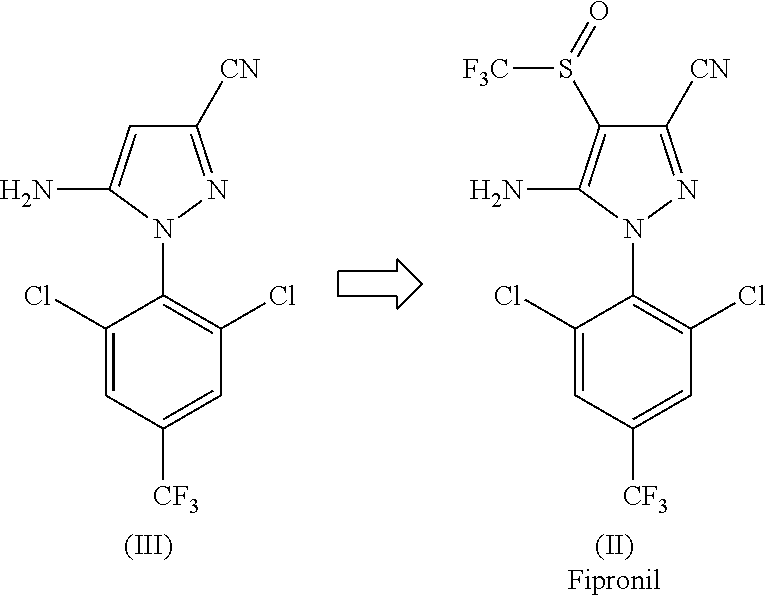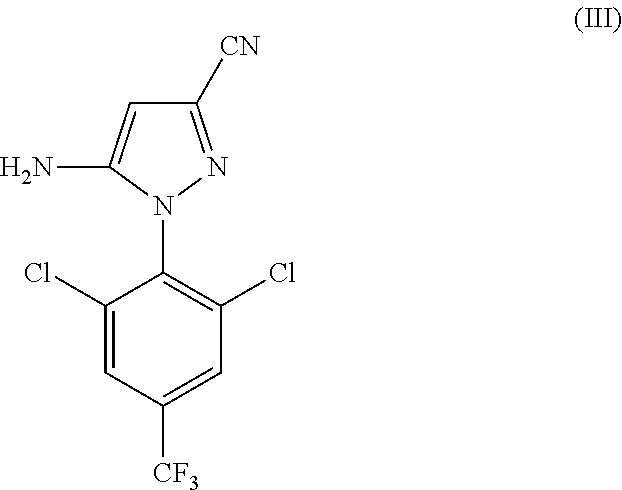Process for the preparation of fipronil and analogues thereof
a technology which is applied in the field of process for the preparation of fipronil and analogues thereof, can solve the problems of corrosive processing, toxicity of some of the starting reagents, and reaction not always proceeding as desired
- Summary
- Abstract
- Description
- Claims
- Application Information
AI Technical Summary
Benefits of technology
Problems solved by technology
Method used
Image
Examples
example 1
Industrial Scale Purification of CF3SO2Na
[0113]In a 500 L reactor, 75.0 kg of commercially available CF3SO2Na was added, followed by 210 kg of ethyl acetate. The resulting mixture was stirred at 25±5° C. for 1 hour. Silicon gel (10.7 kg) was added. The resulting mixture was stirred for 15 minutes, and then filtered by centrifugation. The filter cake (residue) was added to a 200 L reactor and 76.3 kg of ethyl acetate was added. The resulting mixture was stirred at 25±5° C. for 1 hour, and was then filtered by centrifugation. The filter cake (residue) was reintroduced into the reactor and the procedure (ethyl acetate and filtration) was repeated one more time using 76.3 kg of ethyl acetate. The washing process was repeated 2 to 3 times
[0114]The filtrates were combined and 106.6 kg of pure deionized water was added. The resulting mixture was heated to 50±5° C. and was stirred at that temperature for 30 minutes and then cooled to room temperature. The organic layer was separated and 106...
example 2
Industrial Scale Preparation of Catalyst PTSA-NHMe2
[0115]In a 200 L reactor, 70.0 kg of PTSA was added. Me2NH (5805 g, 30% aq. Solution) was added dropwise at 25±5° C. The resulting solution was stirred at that temperature for 1 hour. The solution was then concentrated under vacuum at 70±5° C. Toluene (100.0 kg) was added to the residue. Residual water was removed by azeotropic distillation under vacuum at 70±5° C. When no more water could be separated out, the mixture was cooled to 20±5° C., and filtered over a 1.0 mm porous titanium alloy filtration cartridge with pressure nitrogen purge. The filter cake was dried under vacuum at 70±5° C.
example 3
Industrial Scale Preparation of Compound of Formula I
[0116]In a 200 L reactor, 12.0 kg of 5-amino-1-(2,6-dichloro-4-(trifluoromethyl)phenyl)-1H-pyrazole-3-carbonitrile (compound of formula III), 11.7 kg of CF3SO2Na obtained in Example 1, 12.4 kg of catalyst PTSA.NHMe2 obtained in Example 2, and 90.8 kg of toluene were added. The resulting mixture was stirred at room temperature (25+ / −5° C.) for 15 minutes, and 0.11 kg of DMF was added. The resulting mixture was stirred at room temperature for 30 minutes. The mixture was cooled to 0±2° C., and PCl3 (5.1 g) was added dropwise at that temperature. The resulting mixture was stirred at 0±2° C. for 1 hour. It was then warmed to room temperature and stirred for 1 hour at 20±5° C. The mixture was then heated to ˜65-70° C., and was stirred at that temperature for 8 hours.
[0117]Water (48.0 kg) and 16.1 kg of ethyl acetate were added. The resulting mixture was stirred for 30 minutes, cooled at room temperature and separated. The organic layer ...
PUM
| Property | Measurement | Unit |
|---|---|---|
| molar ratio | aaaaa | aaaaa |
| temperature | aaaaa | aaaaa |
| time period | aaaaa | aaaaa |
Abstract
Description
Claims
Application Information
 Login to View More
Login to View More - R&D
- Intellectual Property
- Life Sciences
- Materials
- Tech Scout
- Unparalleled Data Quality
- Higher Quality Content
- 60% Fewer Hallucinations
Browse by: Latest US Patents, China's latest patents, Technical Efficacy Thesaurus, Application Domain, Technology Topic, Popular Technical Reports.
© 2025 PatSnap. All rights reserved.Legal|Privacy policy|Modern Slavery Act Transparency Statement|Sitemap|About US| Contact US: help@patsnap.com



